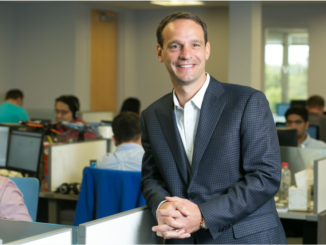
“Enterprise architecture (EA) succeeds when enterprises are treated as complex systems that are constantly changing and adapting,” according to Ken Griesi, a leading practitioner and thought leader in the field. While EA has made major strides to keep up with the latest tech and increasingly connected work environments, it has failed to keep up with business’s most valuable, but most liable asset—its human capital.
Studies show that workers in an average enterprise use upwards of 900 cloud services to get work done. As a result, information workers are overwhelmed and distracted by too many apps that deliver a disconnected experience. Even worse, because it’s so easy to sign up for cloud services today, sensitive business information is spread across multiple apps—whether sanctioned by IT or not—and is getting increasingly harder to keep track of.
This poses a real threat to organizational compliance, and it’s not exclusive to smaller companies with less stringent IT policies. For example, Scottrade was fined $2.6 million in 2015 because it could not produce important e-mails for an audit. Multinational bank Barclays faced a $3.75 million lawsuit in 2013 over its alleged decade-long failure to properly keep electronic records, e-mails, and instant messages. And the list of companies that fail to track critical information is larger than you’d think.
It’s clear that businesses can’t succeed if their employees are forced to work in an enterprise environment that makes it difficult to embrace proper record-keeping. However, in today’s noisy, always-on work reality, people will use whatever tools and processes they need to get work done fast. The only realistic way to mitigate associated risks and improve compliance is for organizations to put people back at the center of their enterprise architecture.
Because human error is a given in any business, information governance and compliance comes down to making the right thing to do the easy thing to do. You can have the best IT policies and procedures in place, but if they’re not easy to follow, they’re useless.
Take e-mail for example—our most used business application. With the sheer amount of e-mails workers receive on a daily basis, potentially millions of e-mails in a given company each year meet business record criteria. Companies have a legal obligation to classify, store, and retrieve these records on demand, especially in highly regulated industries such as healthcare and financial services. However, 63 percent of information governance professionals report that their organizations face challenges with these procedures.
Additionally, 47 percent of information governance professionals pointed to their organization’s inability to find e-mails when they need to, while 21 percent cited difficulty getting e-mails and documents easily into their system of record, followed by challenges with defining content groups and classifying the e-mails appropriately. So, information workers are wasting valuable time sifting through an abundance of e-mails and unorganized files from numerous cloud services, while the opportunity to lose or incorrectly file critical information grows—a lose-lose situation.
To avoid this, businesses need to first take stock of all the devices and services their workers are already using (including any cloud-based apps that employees may have signed up for on their own) because simply telling workers which devices and services they can use is rarely successful. Second, it’s necessary to take into account employees’ existing work patterns, as workers will tend to resist having to learn a new user experience or follow a new protocol. For example, since most workers spend the majority of their time in e-mail and documents, e-mail and document apps should be acknowledged as the main “attention anchors,” and all information should be delivered, or at least accessible, there. The most effective way to do this is to automate the process to ensure documents are classified and saved correctly without workers having to give it too much thought.
The best way to achieve this, and bring the human back to the center of the enterprise architecture, is through an idea called topic computing. Through this approach, information is automatically organized and delivered by topic—the way the human brain works—so workers can stay focused on the task at hand, rather than blindly searching for hard-to-find information or losing it in the shuffle. The concept is to fully unify disconnected information from multiple cloud services by topic within employees’ primary work interface—e-mail.
The benefits of this human-centric approach are two-fold. Organizations can rest assured that their workers are indexing all e-mails and documents accurately and completely. They can find and retrieve e-mail messages, documents, and records for discovery, audits, and compliance requirements at any time to avoid catastrophic legal and financial implications. For information workers, this eliminates an extra step and room for error, making it effortless to comply with e-mail and document retention policies so they can focus on what’s most important to them: their clients and projects.
When it comes to information governance, the best rule of thumb is to make the right thing to do the easy thing to do—and build it into your organization’s enterprise architecture. After all, we’re only human. A&G



